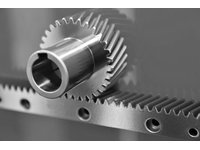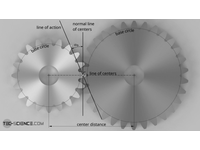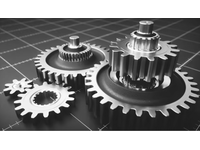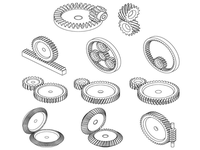Gears & Gear Racks
Gears and gear racks are elements in mechanical systems and play a significant role in transmitting power and motion. Gears are typically circular components with teeth along their circumference, and they mesh with other gears to facilitate controlled rotational movement. Gear racks are straight or flat pieces with similar teeth , usually used with a circular gear.
Gears & Gear Racks BY CATEGORY

Gears
Rotating machine parts with cut teeth utilized to mesh with other toothed component to transmit torque, used in mechanisms to convert the speed and direction of a power source.
Show Gears
Racks
Linear (straight or curved) mechanical components with a series of uniform teeth designed to engage with a gear or pinion to convert rotational motion into linear motion.
Show RacksGears & Gear Racks POPULAR PRODUCTS
Boston 30217252 12734 L505-4 DIAMETRAL PITCH: 24 D.P. NOMINAL LENGTH(FT): 4...
Brand Boston Gear
Model L505-4
S1224 Degree: 14-1/2 Steel Spur Gear
Brand Martin Sprocket
Model S1224
Boston 30235650 54105 GP1632Y DIAMETRAL PITCH: 16 D.P. TEETH: 32 PRESSURE...
Brand Boston Gear
Model GP1632Y
Boston 30217255 12740 L509-6 DIAMETRAL PITCH: 20 D.P. NOMINAL LENGTH(FT): 6...
Brand Boston Gear
Model L509-6

About Gears & Gear Racks
Gears and gear racks are fundamental components in mechanical engineering. With their distinct toothed design, these devices are pivotal in transmitting torque, adjusting rotational speed, and changing the direction of power transmission. By engaging with each other, they can convert linear motion into rotational motion or the other way around, contributing significantly to various applications ranging from analog clocks to automobiles.
Gears are integral components in many mechanical devices, transmitting power, adjusting speed, or changing the direction of force. Several types of gears serve specific applications:
Spur Gears: These are the most common type of gear, characterized by straight teeth mounted parallel to the gear's axis. Spur gears transmit power between parallel shafts.
Helical Gears: Similar to spur gears, their teeth are machined at an angle, allowing for more gradual and smoother gear engagement. Helical gears work well in high-speed applications because they are efficient and quiet.
Bevel Gears: With teeth along the cone surface, these gears change the direction of the shaft's rotation.
Planetary Gears: Consisting of a central 'sun' gear surrounded by 'planet' gears, this setup is used in automobile transmissions to provide different speed and torque outputs.
Worm Gears: These have a unique design where a 'worm' (screw) meshes with a gear/wheel. Worm gears help make significant gear reductions and have the advantage of self-locking.
Each gear type serves a unique purpose in mechanical engineering, contributing to the functionality and efficiency of various devices and machinery.
Gear racks are integral components in many mechanical and automation applications. They are straight bars or rods with teeth cut into them, designed to mesh with gears for converting rotational motion into linear motion. This mechanism works in various industries, such as automotive, manufacturing, and robotics. In the automotive industry, for instance, gear racks are commonly found in steering systems. These help translate the steering wheel's rotational movement into the linear motion for steering the wheels. In robotics, gear racks achieve precise linear motion for tasks such as assembly or positioning.
MRO Supply has a comprehensive gear and gear rack inventory for all your motion and force needs. Because all our products come from reputable manufacturers, you can trust MRO as your one-stop shop for your gear and rack components.
Gears & Gear Racks ARTICLES

All About Rack and Pinion Gears - What They Are and How They Work
Fundamentals Of Rack and Pinions Gears
READ MORE

Engaging of involute gears (meshing)
The points of contact of two meshing tooth flanks describe a straight line for involute gears (line of...
READ MORE

How Gears Work
Gears are used in tons of mechanical devices. Most importantly, they provide a gear reduction in motorized...
READ MORE
Gears & Gear Racks LITERATURE

Gear units and Gearmotors
This manual includes a detailed description of the SEW-EURODRIVE product groups
DOWNLOAD
Bevel Gears
Bevel gears are used as right angle drives where high efficiency is required. Most all of Martin bevel gears are cut with the "coniflex" tooth form to allow for a slight misalignment at assembly and during operation. Gears should be mounted at the correct distance from the core of apex center with thrust bearings being used in back of hubs to absorb the backward thrust created in this type of gearing
DOWNLOAD
Machined Gear Rack
Martin rack is made from low carbon cold drawn steel and cold drawn steel. It is available in 14½° and 20° pressure angle in 2, 4, and 6 foot lengths. Allowance is made for cutting and machining. Pinions to run with the rack may be selected from the spur gear section of the catalog. Special rack can be supplied in other materials, sizes, and pitches
DOWNLOAD














